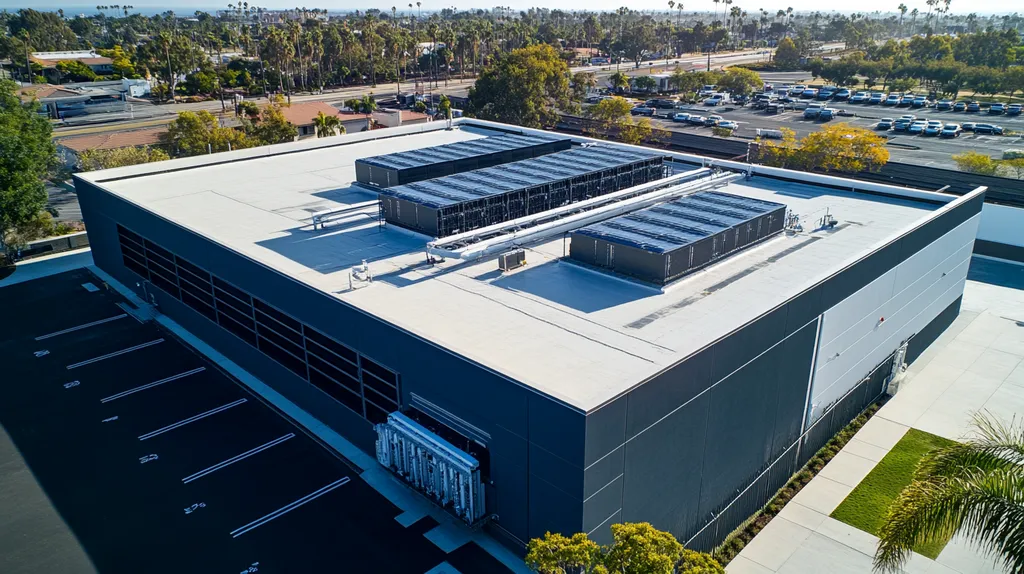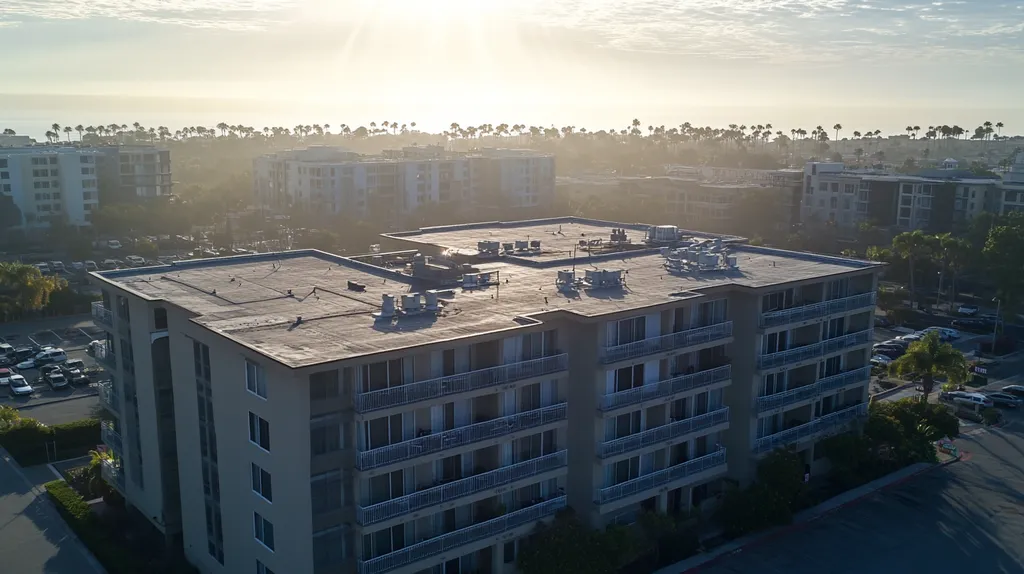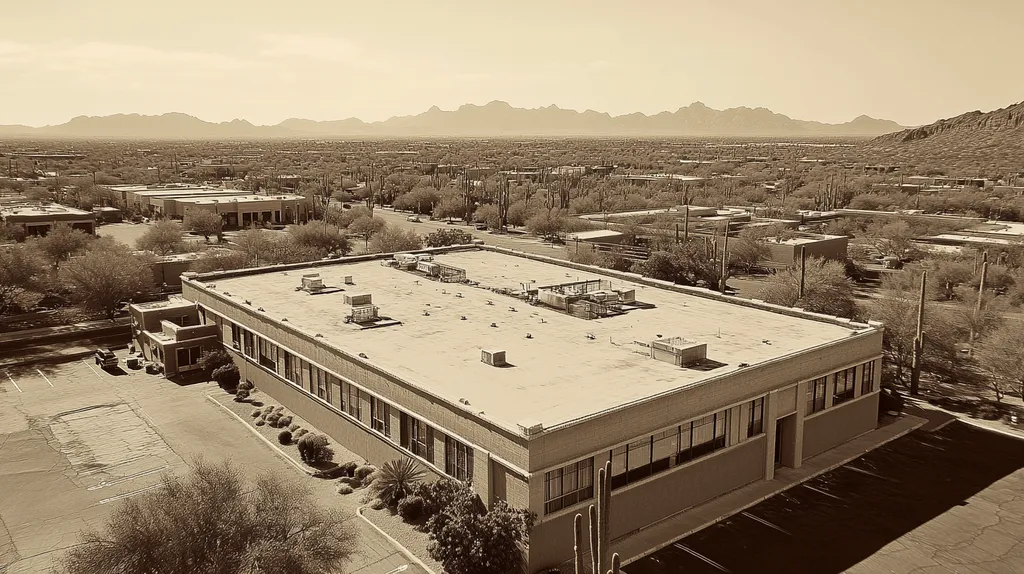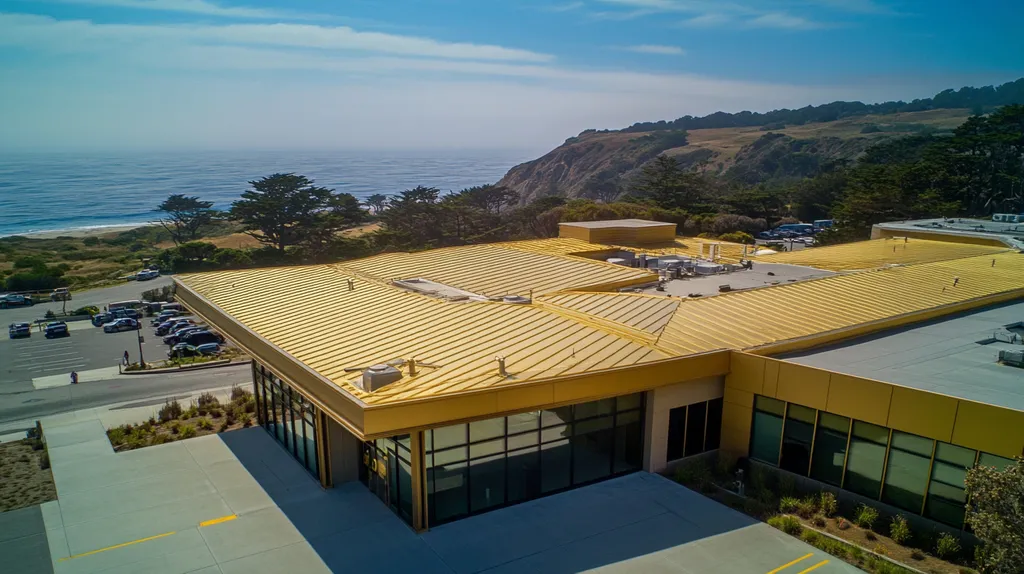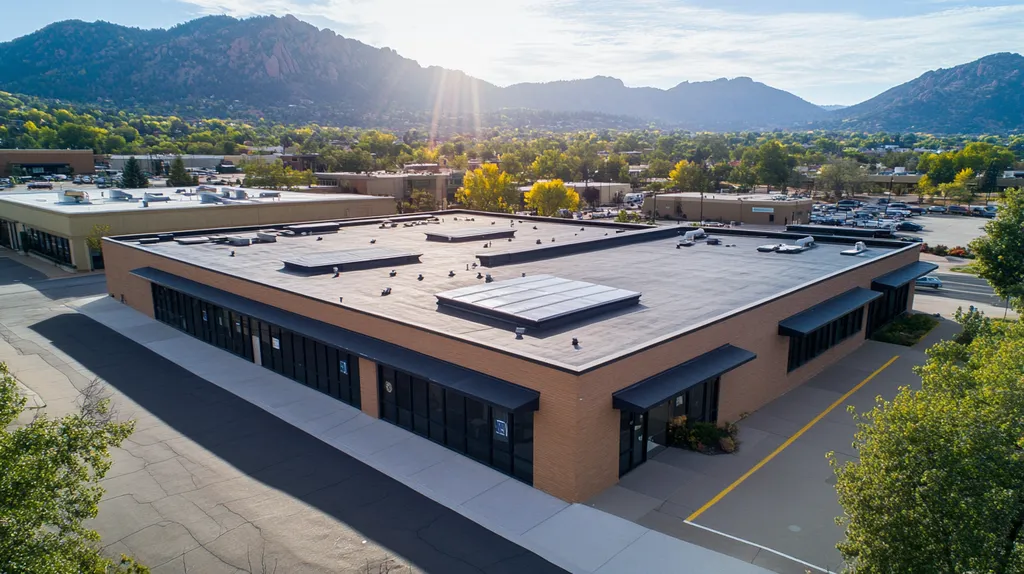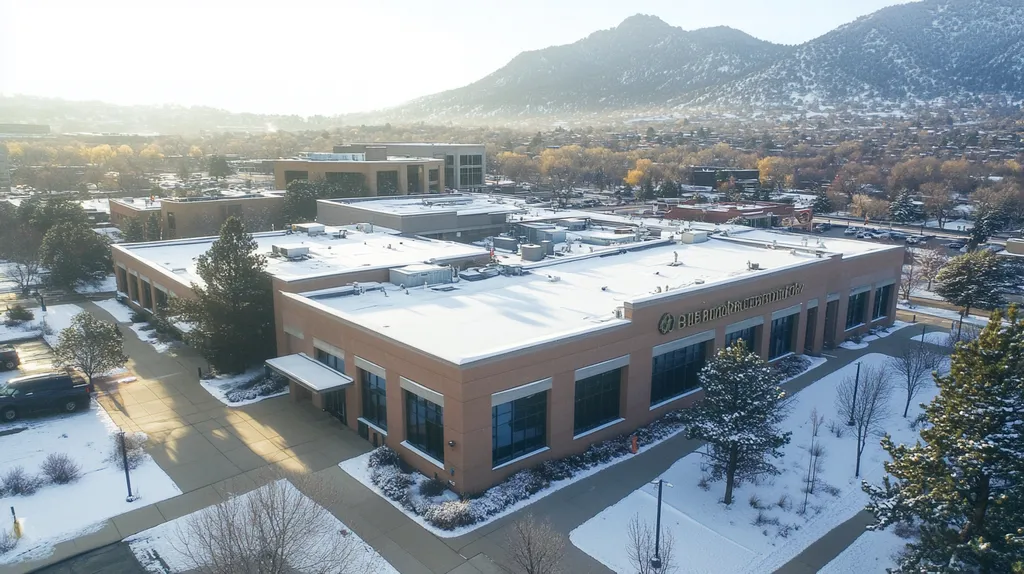Nearly 40% of historical commercial buildings suffer catastrophic roof damage due to improper contractor selection, leading to millions in avoidable repair costs each year.
For property owners and facility managers, finding certified contractors who understand the delicate balance between preserving architectural heritage and ensuring modern performance standards is critical.
This comprehensive guide explores the essential components of historical commercial roofing – from fundamental concepts and system components to implementation methods and maintenance requirements – equipping decision-makers with the knowledge to protect these invaluable structures for generations to come.
SECTION 1: FUNDAMENTAL CONCEPTS
Preserving historical commercial roofs is about more than maintaining a charming facade; it’s an investment in both property value and cultural heritage. These roofs possess distinctive features that demand specialized care and attention. Property owners must grasp the complexities of historic roofing to avoid costly blunders during maintenance and repairs. In this section, we will delve into the essential definitions, explore the materials traditionally used in historical roofing, and examine the regulatory compliance requirements that influence decision-making in this vital area.
Definition of Historic Roofing
Historic roofing encompasses roofing systems that hold architectural importance due to their age, craftsmanship, or technological relevance. Often, these roofs showcase the styles and materials from the era in which they were built. For property owners, recognizing what constitutes a historic roof is crucial. Misclassifying a roof can lead to inappropriate maintenance and repair practices, resulting in expensive renovations.
Generally, roofs that are at least 50 years old qualify as historic. This classification can affect restoration and replacement strategies. Contractors need to embrace techniques that respect the original construction methods, which can be intricate and labor-intensive.
Preserving these roofs not only safeguards individual properties but also helps maintain the cultural identity of communities. The architectural design of a historic roof influences surrounding buildings, contributing to the area’s overall aesthetic appeal.
Overlooking the characteristics of historic roofing can lead to significant problems. Inadequate repairs can undermine the roof’s durability and authenticity, resulting in higher future expenses and a loss of heritage.
Historical Roofing Materials
It’s essential for property owners to understand the range of historical roofing materials when making informed repair or restoration decisions. Common materials include slate, clay tiles, wood shakes, and metal, each with unique attributes that impact longevity and maintenance needs.
For instance, slate is valued for its durability and beauty but requires specialized skills for installation and repairs. Similarly, while clay tiles can last for decades, they are prone to cracking without proper care. Wood shakes add rustic charm but must be regularly treated to ward off rot and insect infestations.
Modern materials may not be suitable for historic roofs due to compatibility issues. When contemporary materials are used, they can detract from the roof’s appearance and structural integrity, ultimately reducing its historical value.
Property owners should seek contractors experienced in these traditional materials to ensure that the correct techniques and products are used. This not only protects the roof’s functionality but also enhances its historical significance.
Regulatory Compliance
Legal regulations play an essential role in the preservation of historical roofs. Local, state, and federal laws often dictate the methods property owners and contractors must follow during restoration efforts. Adhering to these guidelines helps ensure compliance with recognized preservation standards.
For example, buildings located within designated historic districts frequently have stricter regulations concerning material choices and restoration methods. Ignoring these rules can lead to fines or requirements to return the property to its original state, potentially damaging the building’s historical status.
Therefore, it’s vital for property owners to partner with certified contractors who understand the regulatory landscape surrounding historical roofing. This ensures that all work complies with necessary standards, thereby securing any available funding or tax incentives for renovation projects.
Neglecting regulatory compliance not only jeopardizes restoration efforts but also threatens the integrity of the historical site. A proactive approach to meeting legal requirements is fundamental for successful and respectful preservation initiatives.
SECTION 2: SYSTEM COMPONENTS
Understanding the crucial elements of historical commercial roofs is vital for protecting their integrity. Aging materials like slate, tile, and metal require diligent care from certified contractors. Failing to attend to these components can result in costly water damage, structural failures, and even safety hazards. Property owners should familiarize themselves with these system components to make informed decisions that uphold their building’s historical significance.
Slate and Tile Roofing
Slate and tile roofing systems are celebrated for their elegance and durability, but they come with specific challenges. With proper care, these roofs can last over a century; however, factors like severe weather or physical impact can cause individual tiles to crack or dislodge. Certified contractors must conduct thorough assessments to determine the need for restoration or if a full replacement is a more economical choice.
Routine inspections are essential for spotting issues such as water infiltration early, which can threaten the underlying structure. The expertise of certified contractors is invaluable, as they possess the skills necessary to handle these specialized materials. Well-executed repairs can extend the lifespan of slate and tile roofs, preserving their functionality and visual appeal.
Moreover, it’s critical to source materials for slate and tile systems carefully to maintain historical integrity. Using modern equivalents that lack the same properties can lead to performance discrepancies and mismatched aesthetics. Knowledgeable contractors can help property owners choose materials that comply with building codes while honoring historic preservation standards.
In summary, slate and tile roofing demands a proactive maintenance approach from certified professionals to avoid costly repairs and maintain historical authenticity.
Metal Roofing Systems
Metal roofs are increasingly popular due to their durability and ability to withstand harsh weather; however, historical metal roofing presents unique challenges requiring certified expertise. These roofs are susceptible to rust and corrosion, especially in areas plagued by high humidity or pollution. Regular inspections and maintenance become essential to mitigate these risks.
Historically, metal roofing often features materials like copper, zinc, or terne-coated steel. Repairs necessitate not only technical skill but also familiarity with the specific properties of these metals. Using modern substitutes can jeopardize historical accuracy, underscoring the importance of hiring certified contractors who specialize in preservation.
Seams and fasteners are crucial areas that warrant scrutiny. Poor sealing can lead to leaks, stressing the need for a thorough approach to maintenance. A contractor’s knowledge of the original installation methods can significantly impact the longevity and performance of the roofing system.
Different metals react uniquely to environmental conditions and coatings. An expert contractor will be aware of the best practices for treating and maintaining these surfaces to enhance both their lifespan and appearance. Ignoring the needs of metal roofs can lead to increasingly steep repair costs, highlighting the necessity for knowledgeable professional care.
Roof Penetrations and Flashing
Roof penetrations and flashing are critical elements that require careful attention in historical buildings. These areas often accommodate vents, chimneys, and skylights, making them potential entry points for water damage. If not properly maintained, they can lead to severe leaks and structural issues.
Maintaining the integrity of flashing materials is particularly essential. Traditional flashing might include materials like lead or copper, each requiring specialized installation and repair techniques. Certified contractors adept in historical roofing understand the nuances needed to ensure these components perform optimally.
Incorrectly installed or worn flashing can result in significant repair expenses over time. Additionally, flashings must be compatible with the roofing material to create effective seals. Certified professionals will evaluate each penetration to recommend necessary repairs or replacements that maintain historical value while ensuring adequate protection.
In conclusion, prioritizing the maintenance of roof penetrations and flashing to historical standards is essential. Engaging certified contractors can safeguard a building’s future while honoring its past.
SECTION 3: IMPLEMENTATION METHODS
When it comes to preserving historical commercial roofs, the stakes couldn’t be higher. The right implementation methods can spell the difference between maintaining a building’s charm and incurring financially crippling repairs. A National Trust report warns that neglecting proper roofing practices can lead to dire structural issues, jeopardizing our cherished historical landmarks. In this section, we’ll explore essential methods, including surgical roof disassembly, the significance of selecting qualified contractors, and the advantages of custom metal roofing installations.
Surgical Roof Disassembly
Surgical roof disassembly is a precise and careful approach critical for preserving the integrity of historical roofs. This technique focuses on removing only the sections that need repair or replacement, allowing for minimal disruption to the building’s overall structure. For example, a historic theater in Boston successfully utilized surgical disassembly to replace only the damaged slate tiles.
This method not only curtails expenses but also protects the original materials that enhance a building’s historical character. Certified contractors equipped with specialized tools ensure that existing roofing elements remain unharmed during the process, adhering to preservation standards established by historic societies.
Moreover, surgical disassembly enables a thorough examination of underlying issues without compromising the exterior charm. This proactive measure can unveil hidden water damage or structural weaknesses, helping owners prevent larger, more costly repairs in the future.
Ultimately, surgical disassembly ensures that the unique features of historical roofs are honored while allowing for necessary improvements. This method is vital for crafting a restoration plan that aligns with legal regulations and historical preservation guidelines.
Qualified Contractor Selection
Choosing a qualified contractor is a pivotal step in ensuring the success of historical roofing projects. Property owners should focus on hiring contractors who are specifically certified in historical restoration, as this designation reflects a deep understanding of the unique challenges tied to these roofs.
Contractors with a strong track record in historical restorations are well-versed in utilizing the original materials and techniques that were employed when the roof was initially built. Their expertise is invaluable in maintaining authenticity while modernizing roofing systems. Many experienced contractors also offer warranties that protect investments in these significant structures against potential failures later on.
To ensure a suitable selection, property owners should carry out thorough due diligence. Checking references, reviewing past projects, and verifying training credentials can help confirm the contractor’s competence. On-site evaluations can provide further insight into each contractor’s capability to successfully navigate the complexities of historical roofing.
Engaging in clear communication with selected contractors promotes transparency throughout the project lifecycle. Establishing clear agreements on timelines, materials, and costs helps align expectations, minimizing misunderstandings. By collaborating with a qualified contractor, property owners can safeguard historical integrity while fulfilling contemporary needs.
Custom Metal Roofing Installation
Custom metal roofing installations represent an innovative solution for historical buildings that need both durability and aesthetic fidelity. These roofs can be specially crafted to reflect historical styles, merging visual appeal with modern technology. For instance, a custom metal roof successfully installed on a historic library in St. Louis preserved its iconic look while boosting its durability.
Metal roofing options are increasingly popular due to their longevity and ability to withstand harsh weather conditions. In regions facing severe climates, this resilience allows for a reinterpretation of historical architectural styles while protecting the structural components beneath the roof. These long-term benefits can lead to reduced maintenance expenses.
Additionally, custom metal roofing can be designed to mimic traditional materials, such as clay tiles or slate, ensuring historical accuracy. This approach maintains aesthetic continuity and complies with preservation guidelines enforced by local historical societies. Advancements in coating technology also improve energy efficiency, further enhancing the building’s value.
In conclusion, custom metal roofing provides a modern yet respectful solution for historical restoration. Property owners can modernize their roofs with confidence, honoring the legacy of their buildings and contributing to sustainable preservation for the future.
SECTION 4: MAINTENANCE REQUIREMENTS
Maintaining historical commercial roofs is not just a smart choice; it’s essential for safeguarding both property integrity and value. Studies reveal that implementing consistent, structured maintenance can extend the lifespan of roofing systems by 20% or more. Property owners must commit to rigorous maintenance protocols to prevent costly repairs and fend off significant weather damage.
Regular Inspection Protocols
Establishing regular inspection protocols is vital for the health of historical roofs. Inspections should take place at least twice a year—in spring and fall—to catch signs of wear, damage, or leaks. It’s best to have trained professionals conduct these inspections and document their findings in detail.
During inspections, pay special attention to critical areas like flashing, seams, and drainage systems. These components are often the first to show signs of wear due to relentless weather exposure. Early detection of potential issues can keep minor repairs from ballooning into major expenses.
Additionally, clearing any vegetation or debris from the roof is essential. Plant life can trap moisture, leading to premature deterioration of roofing materials. A little routine cleaning can go a long way in extending the roof’s lifespan.
Ultimately, adhering to a thorough inspection schedule not only shields the roof but also grants peace of mind to property owners.
Preventive Maintenance Strategies
Preventive maintenance strategies are key to reducing surprises. Routine tasks like cleaning gutters and downspouts are simple yet impactful in preventing water buildup. Standing water can cause leaks, which are harmful to historical roofing materials.
Property managers should also consider applying protective coatings when appropriate. These coatings can enhance roofing materials’ longevity by providing UV protection and improving water resistance. Consulting certified contractors is advisable when selecting the right products for historical roofs.
Another effective strategy involves managing the landscape surrounding the building. Overhanging branches can scrape roofing materials and drop leaves that trap moisture. Keeping trees trimmed and foliage in check significantly reduces these risks, thereby improving the roof’s durability.
By implementing these preventive measures, property owners can substantially lower maintenance costs while extending their roof’s life, ultimately protecting their investment.
Repairing Common Failures
Even with all precautions, repairs may become necessary. Common issues with historical roofs include cracking, leaking, and material degradation. When these problems arise, taking swift action is crucial to prevent further damage.
For leaks, a detailed examination is critical. Finding the source can be tricky, often requiring a close inspection by professionals. Once the leak is located, property owners must prioritize repairs to avoid water damage that could affect the interior of the building.
Cracked materials can also be effectively managed through patch repairs or overlays. Depending on the roofing type, using the right materials ensures compatibility and longevity. Certified contractors are ideally suited to recommend the best repair methods.
Finally, maintaining a detailed log of repairs and inspections is essential. This documentation provides insight into the roof’s history and can be invaluable for future maintenance plans or renovations.
SECTION 5: PERFORMANCE METRICS
When it comes to historical commercial roofs, the stakes are extraordinarily high. A roof that fails to perform can lead to crippling repair costs, diminish property value, and even create safety risks for tenants and visitors. Alarmingly, nearly 30% of roof failures result from insufficient performance metrics during the selection process. That’s why property owners and facility managers must prioritize key performance indicators—durability, weather resistance, and energy efficiency—to ensure their roofs stand the test of time while safeguarding their investments.
Durability and Longevity
Durability isn’t just a nice-to-have; it’s a critical metric for historical roofs, where the effects of time and weather can be heightened. A roof that successfully lasts 20 years or more is vital for preserving the historical integrity of these unique structures. Opting for roofing materials that meet or often exceed industry longevity standards can save property owners from significant future expenses.
For instance, well-installed slate and tile roofs can last over a century with proper maintenance. Certified contractors will choose robust materials that honor the building’s historical context while boosting performance longevity. This approach not only fulfills aesthetic expectations but also enhances the roof’s lifespan.
Installation techniques also play a major role in durability. Poorly executed installations can lead to leaks and extensive damage that undermine the entire system’s lifespan. Certified professionals are trained to deploy methods that will stand up against various environmental stressors, preserving the roof’s structural integrity.
Finally, adhering to a regular maintenance schedule—typically every few years—is essential for sustaining durability. By aligning maintenance strategies with performance metrics, facility managers can proactively tackle issues before they escalate into costly repairs.
Weather Resistance Testing
Weather resistance stands out as another essential performance metric, especially for historical roofs enduring extreme weather conditions. Insufficient protection against the elements can lead to moisture intrusion, mold growth, and structural deterioration. Thus, conducting rigorous weather resistance testing for roofing materials is vital.
Take, for example, materials like modified bitumen and elastomeric membranes; they have undergone stringent testing to withstand wind, rain, and snow. These durable materials thrive in high-stress environments, giving property owners peace of mind. Certified contractors skillfully implement these tested materials to ensure reliable performance across a variety of weather conditions.
Additionally, understanding the unique structural designs of historical roofs can lead to enhanced weather resistance. Engineers and contractors familiar with the challenges posed by older buildings can propose solutions that boost durability while respecting the building’s architectural significance.
Investing in weather-resistant roofing not only fortifies the structure but can also lead to insurance benefits. Many insurance providers offer reduced premiums for well-protected properties, generating additional savings for proactive property owners.
Energy Efficiency Standards
Energy efficiency is becoming an increasingly important performance metric for historical commercial roofs, as it directly impacts operating costs and overall sustainability. Poor thermal performance can inflate energy bills—especially for older buildings with outdated insulation. Implementing energy-efficient standards helps mitigate these challenges.
For example, adding reflective roof coatings can significantly lessen heat absorption, resulting in cooler indoor temperatures. According to the U.S. Department of Energy, reflective roofing can lower energy consumption by up to 15%. Certified contractors are equipped to recommend energy-efficient options that harmonize with both historical preservation and modern energy guidelines.
Moreover, building codes frequently mandate minimum energy efficiency standards, urging property owners to select higher-performing materials. Non-compliance can result in fines or increased costs during building retrofits. Meeting or exceeding these standards not only ensures compliance but also elevates property value.
Lastly, enhancing energy efficiency through insulation upgrades during roof replacements can provide immediate advantages. A properly insulated roof maintains stable interior temperatures, contributing to long-term savings and comfort.
SECTION 5: PERFORMANCE METRICS
When it comes to historical commercial roofs, the stakes are remarkably high. A roof that underperforms can trigger expensive repairs, lower property value, and pose safety hazards for tenants and visitors alike. Shockingly, nearly 30% of roof failures stem from insufficient performance metrics in the selection process. To avoid these pitfalls, property owners and facility managers must prioritize key performance indicators such as durability, weather resistance, and energy efficiency to ensure their roofs stand strong while protecting their investments.
Durability and Longevity
Durability is not just a buzzword for historical roofs; it is a critical metric where the toll of time and harsh weather can be magnified. A roof that lasts 20 years or beyond is essential for safeguarding the integrity of these impressive structures. Selecting roofing materials that meet or even exceed industry longevity standards can save property owners significant expenses down the road.
For illustration, well-installed slate and tile roofs can endure for more than a century with the right maintenance. Certified contractors choose strong materials that celebrate the architectural history of the building while enhancing its performance longevity. This careful selection helps to keep both aesthetic value and structural integrity intact.
Moreover, the installation process is paramount to ensuring durability. A shoddy installation can open the door to leaks and extensive damage, potentially undermining the entire roofing system. Certified professionals are trained to implement techniques that allow roofs to withstand various environmental stress factors over time.
Regular maintenance, generally suggested every few years, is also key in preserving durability. By aligning maintenance strategies with performance metrics, facility managers can proactively nip issues in the bud and avoid costly repairs later on.
Weather Resistance Testing
Weather resistance is another vital performance metric for roofs facing severe environmental conditions. Inadequate protection against the elements can lead to moisture intrusion, mold growth, and structural degradation. Therefore, rigorous weather resistance testing of roofing materials is imperative.
Consider materials such as modified bitumen and elastomeric membranes, which have passed stringent testing protocols to thrive in harsh climates. These materials provide peace of mind to property owners by demonstrating their ability to resist wind, rain, and snow. Certified contractors are trained to incorporate such tested materials into installations, ensuring reliable performance through diverse weather conditions.
Additionally, appreciating the unique structural design of historical roofs can enhance weather resistance even further. Contractors familiar with the particular challenges presented by older buildings can suggest tailored solutions that amplify durability while honoring the building’s special character.
Investing in weather-resistant roofing is not just a matter of protection; it can also translate into potential insurance savings. Many insurers offer discounts for properties with proven weather resilience, providing financial relief to proactive property owners.
Energy Efficiency Standards
Energy efficiency is now a critical metric, especially for historical commercial roofs, impacting both operating costs and sustainability efforts. A poor level of thermal performance can lead to unacceptably high energy bills, particularly for older structures with outdated insulation. Implementing energy-efficient standards is essential for tackling these concerns.
For example, applying reflective roof coatings can dramatically reduce heat absorption, resulting in cooler indoor environments. As stated by the U.S. Department of Energy, reflective roofing can decrease energy consumption by as much as 15%. Certified contractors can recommend energy-efficient options that align well with the needs of historical preservation while meeting modern energy guidelines.
Moreover, building codes frequently set minimum energy efficiency benchmarks, urging property owners to opt for higher-performing materials. Non-compliance could lead to fines or additional costs during renovations, making adherence not only wise but essential. Meeting or surpassing these standards not only ensures regulatory compliance but also enhances the property’s overall value.
Finally, enhancing energy efficiency during roof replacements through insulation upgrades can lead to immediate, beneficial outcomes. A roof with proper insulation helps maintain stable indoor temperatures, leading to long-term financial savings and increased comfort.
The Bottom Line
With 40% of historical commercial buildings at risk of catastrophic roof damage, selecting certified contractors isn’t just advisable – it’s essential for survival.
These specialized professionals bring critical expertise in surgical disassembly techniques, historically accurate materials, and preservation-compliant installation methods that protect both the building’s integrity and its cultural significance.
From regular inspections and preventive maintenance to performance testing and energy optimization, certified contractors provide the comprehensive oversight these irreplaceable structures demand.
By partnering with qualified contractors who understand historical roofing complexities, property owners can avoid the staggering costs of improper repairs while ensuring these architectural treasures endure for generations to come.
FREQUENTLY ASKED QUESTIONS
Q. What is a historic roofing system for commercial roofs?
A. A historic roofing system refers to roofs that have architectural significance due to their age or craftsmanship. These roofs often date back at least 50 years, showcasing materials and techniques from their time. Understanding these definitions is vital for proper maintenance and avoiding costly mistakes.
Q. What components are essential for maintaining an industrial roof?
A. Key components for maintaining an industrial roof include slate, tiles, and flashings. Regular inspections help identify any cracks or leaks early on. Engaging certified contractors ensures that specialized care for these components aids in preserving their integrity and functionality.
Q. What are effective methods for implementing roof repairs?
A. Surgical roof disassembly is an effective method, allowing targeted repairs with minimal disruption. It’s important to hire qualified contractors who understand historical restoration techniques to ensure structural integrity. Thorough examination during repairs is vital for addressing underlying issues proactively.
Q. How can I ensure proper maintenance of my commercial roof?
A. Regular inspections at least twice yearly are crucial for maintaining your commercial roof. Focus on areas like flashing and drainage, as they often reveal wear first. Additionally, preventive maintenance tasks, such as clearing debris, greatly contribute to extending your roof’s lifespan.
Q. Why are performance metrics important for an industrial roof?
A. Performance metrics such as durability, weather resistance, and energy efficiency directly impact your roof’s functionality. Poor performance can lead to significant repairs and decreased property value. Prioritizing these metrics helps ensure long-lasting protection and enhances overall building sustainability.
Q. How can I choose the right contractor for historical roofs?
A. Selecting the right contractor involves checking for specific certifications in historical restorations. Review their past projects and references to gauge their expertise. A qualified contractor will deeply understand the unique challenges of maintaining historical commercial roofs while adhering to preservation standards.
Q. What materials are commonly used for historical commercial roofs?
A. Common materials include slate, clay tiles, wood shakes, and traditional metals. Each material has distinct maintenance needs and longevity expectations. Engaging certified contractors ensures that suitable and compatible materials are used to protect the roof’s historical integrity.

